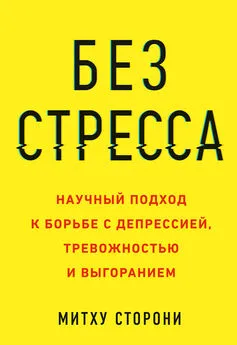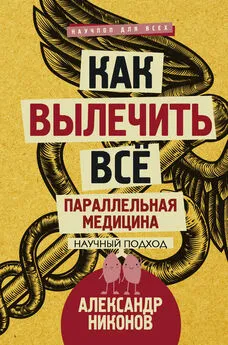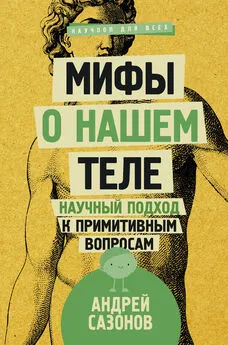Митху Сторони - Без стресса. Научный подход к борьбе с депрессией, тревожностью и выгоранием
- Название:Без стресса. Научный подход к борьбе с депрессией, тревожностью и выгоранием
- Автор:
- Жанр:
- Издательство:Литагент МИФ без БК
- Год:2019
- Город:Москва
- ISBN:978-5-00117-633-6
- Рейтинг:
- Избранное:Добавить в избранное
-
Отзывы:
-
Ваша оценка:
Митху Сторони - Без стресса. Научный подход к борьбе с депрессией, тревожностью и выгоранием краткое содержание
На русском языке публикуется впервые.
Без стресса. Научный подход к борьбе с депрессией, тревожностью и выгоранием - читать онлайн бесплатно ознакомительный отрывок
Интервал:
Закладка:
J. A. Robinson and K. L. Swanson, «Field and Observer Modes of Remembering». Memory 1, no. 3 (Sept. 1993): 169–184.
72
K. E. Gilbert, S. Nolen-Hoeksema, and J. Gruber, «Positive Emotion Dysregulation across Mood Disorders: How Amplifying versus Dampening Predicts Emotional Reactivity and Illness Course». Behaviour Research and Therapy 51, no. 11 (Nov. 2013): 736–741.
73
Копинг ( англ . coping – преодоление) – действия человека, с помощью которых он борется со стрессом.
74
E. Watkins, «Adaptive and Maladaptive Ruminative Self-focus during Emotional Processing». Behaviour Research and Therapy 42, no. 9 (Sept. 2004): 1037–1052.
75
J. van Lier, M. L. Moulds, and F. Raes, «Abstract ‘Why’ Thoughts about Success Lead to Greater Positive Generalization in Sport Participants». Frontiers in Psychology 6 (Nov. 2015): 1783.
76
F. Wang, C. Wang, Q. Yin, K. Wang, D. Li, M. Mao, C. Zhu, and Y. Huang, «Reappraisal Writing Relieves Social Anxiety and May be Accompanied by Changes in Frontal Alpha Asymmetry». Frontiers in Psychology 21, no. 6 (Oct. 2015): 1604.
77
Бинауральные ритмы (от лат. bini – пара, два и auris – ухо) – артефакт работы головного мозга, воображаемые звуки управляемой музыки, которые мозг воспринимает («слышит»), хотя реальные звуки этой частоты отсутствуют.
78
R. F. Helfrich and R. T. Knight, «Oscillatory Dynamics of Prefrontal Cognitive Control». Trends in Cognitive Science 20, no. 12 (Dec. 2016): 916–930.
79
K. Song, M. Meng, L. Chen, K. Zhou, and H. Luo, «Behavioral Oscillations in Attention: Rhythmic α Pulses Mediated Through θ Band». Journal of Neuroscience 34, no. 14 (Apr. 2014): 4837–4844.
80
H. S. Lee, A. Ghetti, A. Pinto-Duarte, X. Wang, G. Dziewczapolski, F. Galimi, S. Huitron-Resendiz, J. C. Piña-Crespo, A. J. Roberts, I. M. Verma, T. J. Sejnowski, and S. F. Heinemann, «Astrocytes Contribute to Gamma Oscillations and Recognition Memory». Proceedings of the National Academy of Sciences of the United States of America 111, no. 32 (Aug. 2014): E3343–3352.
81
P. Billeke, F. Zamorano, D. Cosmelli, and F. Aboitiz, «Oscillatory Brain Activity Correlates with Risk Perception and Predicts Social Decisions». Cerebral Cortex 23, no. 12 (Dec. 2013): 2872–780.
82
B. Voloha, T. Valiante, S. Everling, and T. Womelsdorf, «Theta-gamma Coordination between Anterior Cingulate and Prefrontal Cortex Indexes Correct Attention Shifts». Proceedings of the National Academy of Sciences of the United States of America 112, no. 27 (Jul. 2015): 8457–8462.
83
M. Ertl, M. Hildebrandt, K. Ourina, G. Leicht, and C. Mulert, «Emotion Regulation by Cognitive Reappraisal – The Role of Frontal Theta Oscillations». NeuroImage 81 (Nov. 2013): 412–421.
84
R. F. Helfrich, T. R. Schneider, S. Rach, S. A. Trautmann-Lengsfeld, A. K. Engel, et al., «Entrainment of Brain Oscillations by Transcranial Alternating Current Stimulation». Current Biology 24 (2014): 333–339.
85
M. Bonnefond and O. Jensen, «Alpha Oscillations Serve to Protect Working Memory Maintenance against Anticipated Distracters». Current Biology 22 (2012): 1969–1974.
86
C. F. Lavallee, S. A. Koren, and M. A. Persinger, «A Quantitative Electroencephalographic Study of Meditation and Binaural Beat Entrainment». Journal of Alternative and Complementary Medicine 17, no. 4 (Apr. 2011): 351–355.
87
L. Chaieb, E. C. Wilpert, T. P. Reber, and J. Fell, «Auditory Beat Stimulation and its Effects on Cognition and Mood States». Frontiers in Psychiatry 6 (May 2015): 70.
88
H. Wahbeh, C. Calabrese, H. Zwickey, and D. Zajdel, «Binaural Beat Technology in Humans: A Pilot Study to Assess Neuropsychologic, Physiologic, and Electroencephalographic Effects». Journal of Alternative and Complementary Medicine 13, no. 2 (Mar. 2007): 199–206.
89
R. Padmanabhan, A. J. Hildreth, and D. Laws, «A Prospective, Randomised, Controlled Study Examining Binaural Beat Audio and Preoperative Anxiety in Patients Undergoing General Anaesthesia for Day Case Surgery». Anaesthesia 60, no. 9 (Sept. 2005): 874–877.
90
P. A. McConnell, B. Froeliger, E. L. Garland, J. C. Ives, and G. A. Sforzo, «Auditory Driving of the Autonomic Nervous System: Listening to Theta-frequency Binaural Beats Post-exercise Increases Parasympathetic Activation and Sympathetic Withdrawal». Frontiers in Psychology 14, no. 5 (Nov. 2014): 1248.
91
K. Unno, K. Iguchi, N. Tanida, K. Fujitani, N. Takamori, H. Yamamoto, N. Ishii, H. Nagano, T. Nagashima, A. Hara, K. Shimoi, and M. Hoshino, «Ingestion of Theanine, an Amino Acid in Tea, Suppresses Psychosocial Stress in Mice». Experimental Physiology 98, no. 1 (Jan. 2013): 290–303.
92
A. L. Lardner, «Neurobiological Effects of the Green Tea Constituent Theanine and its Potential Role in the Treatment of Psychiatric and Neurodegenerative Disorders». Nutritional Neuroscience 17, no. 4 (Jul. 2014): 145–155.
93
D. A. Camfield, C. Stough, J. Farrimond, and A. B. Scholey, «Acute Effects of Tea Constituents L-theanine, Caffeine, and Epigallocatechin Gallate on Cognitive Function and Mood: A Systematic Review and Meta-analysis». Nutrition Reviews 72, no. 8 (Aug. 2014): 507–522.
94
S. Borgwardt, F. Hammann, K. Scheffler, M. Kreuter, J. Drewe, and C. Beglinger, «Neural Effects of Green Tea Extract on Dorsolateral Prefrontal Cortex». European Journal of Clinical Nutrition 66, no. 11 (Nov. 2012): 1187–1192.
95
Урасэнкэ – название семьи, дома, расположенного в Киото, Япония, члены которого вот уже на протяжении пятнадцати поколений профессионально занимаются искусством чая.
96
http://www.thenational.ae/news/peacefulness-through-a-bowl-of-tea.
97
N. Skoluda, J. Strahler, W. Schlotz, L. Niederberger, S. Marques, S. Fischer, M. V. Thoma, C. Spoerri, U. Ehlert, and U. M. Nater, «Intraindividual Psychological and Physiological Responses to Acute Laboratory Stressors of Different Intensity». Psychoneuroendocrinology 51 (Jan. 2015): 227–236.
98
J. LeMoult and J. Joormann, «Depressive Rumination Alters Cortisol Decline in Major Depressive Disorder». Biological Psychology 100 (Jul. 2014): 50–55.
99
J. F. Brosschot, W. Gerin, and J. F. Thayer, «Worry and Health: The Perseverative Cognition Hypothesis». Journal of Psychosomatic Research 60 (2006): 113–124.
100
S. Nolen-Hoeksema, «The Role of Rumination in Depressive Disorders and Mixed Anxiety/Depressive Symptoms». Journal of Abnormal Psychology 109, no. 3 (2000): 504–511.
101
J. Morrow and S. Nolen-Hoeksema, «Effects of Responses to Depression on the Remediation of Depressive Affect». Journal of Personality and Social Psychology 58, no. 3 (1990): 519–527.
102
M. Glynn, N. Christenfeld, and W. Gerin, «The Role of Rumination in Recovery from Reactivity: Cardiovascular Consequences of Emotional States». Psychosomatic Medicine 64, no. 5 (2002): 714–726.
103
W. Gerin, K. W. Davidson, N. J. S. Christenfeld, T. Goyal, and J. E. Schwartz, «The Role of Angry Rumination and Distraction in Blood Pressure Recovery from Emotional Arousal». Psychosomatic Medicine 68 (2006): 64–72.
104
B. L. Key, T. S. Campbell, S. L. Bacon, and W. Gerin, «The Influence of Trait and State Rumination on Cardiovascular Recovery from a Negative Emotional Stressor». Journal of Behavioral Medicine 31 (2008): 237–248.
105
D. Gianferante, M. V. Thoma, L. Hanlin, et al., «Post-stress Rumination Predicts HPA Axis Responses to Repeated Acute Stress». Psychoneuroendocrinology 49 (2014): 244–252, doi: 10.1016/j.psyneuen.2014.07.021.
106
R. B. Price, B. Paul, W. Schneider, and G. J. Siegle, «Neural Correlates of Three Neurocognitive Intervention Strategies: A Preliminary Step Towards Personalized Treatment for Psychological Disorders». Cognitive Therapy and Research 37, no. 4 (Aug. 2013): 657–672.
107
J. Skorka-Brown, J. Andrade, and J. May, «Playing ‘Tetris’ Reduces the Strength, Frequency and Vividness of Naturally Occurring Cravings». Appetite 76 (May 2014): 161–165.
108
E. E. Hill, E. Zack, C. Battaglini, M. Viru, A. Viru, and A. C. Hackney, «Exercise and Circulating Cortisol Levels: The Intensity Threshold Effect». Journal of Endocrinological Investigation 31, no. 7 (Jul. 2008): 587–591.
109
E. Puterman, A. O’Donovan, N. E. Adler, A. J. Tomiyama, M. Kemeny, O. M. Wolkowitz, and E. Epel, «Physical Activity Moderates Effects of Stressor-induced Rumination on Cortisol Reactivity». Psychosomatic Medicine 73, no. 7 (Sept. 2011): 604–611.
110
Дыхательный паттерн – совокупность временн ы х и объемных характеристик дыхательного центра, таких как: 1) частота дыхания; 2) продолжительность дыхательного цикла; 3) дыхательный объем; 4) минутный объем; 5) максимальная вентиляция легких, резервный объем вдоха и выдоха; 6) жизненная емкость легких.
111
B. Oneda, K. C. Ortega, J. L. Gusmão, T. G. Araújo, and D. Mion, Jr., «Sympathetic Nerve Activity is Decreased during Device-guided Slow Breathing». Hypertension Research 33, no. 7 (Jul. 2010): 708–712.
112
D. Harada, H. Asanoi, J. Takagawa, H. Ishise, H. Ueno, Y. Oda, Y. Goso, S. Joho, and H. Inoue, «Slow and Deep Respiration Suppresses Steady-state Sympathetic Nerve Activity in Patients with Chronic Heart Failure: From Modeling to Clinical Application». American Journal of Physiology-Heart and Circulatory Physiology 307, no. 8 (Oct. 2014): H1159–1168.
113
R. Padmanabhan, A. J. Hildreth, and D. Laws, «A Prospective, Randomised, Controlled Study Examining Binaural Beat Audio and Pre-operative Anxiety in Patients Undergoing General Anaesthesia for Day Case Surgery». Anaesthesia 60 (2005): 874–877.
Читать дальшеИнтервал:
Закладка:









